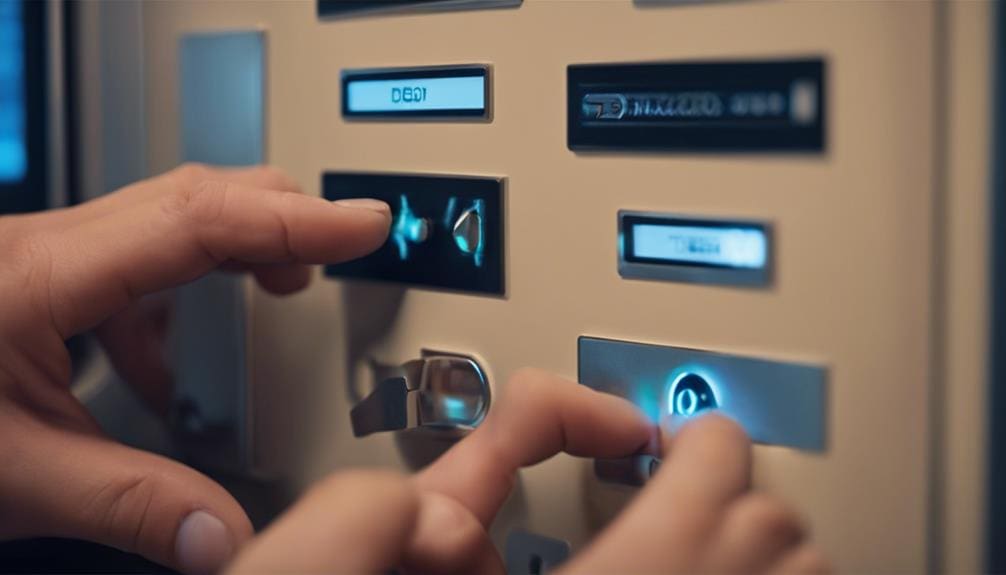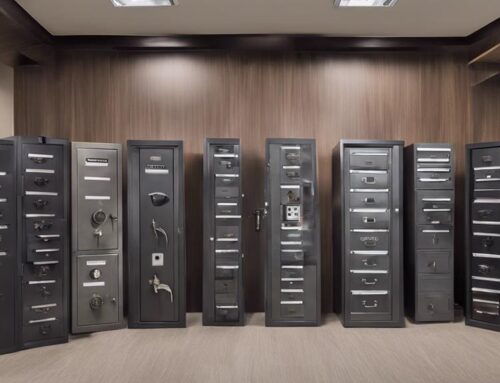Safe override keys bypass electronic locks by activating the mechanical part of the safe. You’ll find the key slot behind a discreet panel. Insert and turn the key to disengage the electronic lock. Use the override key during electronic failures or emergencies like dead batteries or malfunctions. Store the key securely to prevent unauthorized access. Regularly test the key to guarantee it works properly. For complex issues, professional locksmiths can help. Understanding these steps will help you be ready to manage safe access effectively in various situations. Stay tuned for detailed guidance on making the most of your safe’s security features.
Key Takeaways
- Override keys bypass electronic locks by engaging the manual mechanism to ensure access during electronic failures or emergencies.
- Insert the override key into the designated slot, usually behind a removable panel, and turn to disengage the electronic lock.
- Override keys are critical backups for scenarios like battery depletion, electronic malfunctions, or forgotten passwords.
- Mechanical override keys offer a straightforward access method, while electronic keys may require specific tools or knowledge.
- Securely store override keys to prevent unauthorized access and maintain the security of safe contents.
What Are Safe Override Keys?
Safe override keys are physical keys designed to bypass electronic locking mechanisms on safes, providing a reliable backup method for accessing your valuables. When an electronic lock fails or you forget the access code, these keys become essential. They activate the mechanical part of the lock, allowing you to open the safe without needing the electronic system.
To use an override key, locate the keyhole hidden behind a discreet panel or cover on your safe. Insert the key and turn it, just like you would with any traditional lock. This action triggers the mechanical lock inside, granting you access to your safe’s contents. It’s a straightforward process, but it ensures that you’re not locked out in important situations.
Locksmiths often rely on override keys for safes when electronic components malfunction or codes are lost. These keys form an important part of your security backup plan, making sure you always have a way to access your valuables. By understanding how safe override keys function, you can appreciate their role in maintaining the security and accessibility of your safe. Always keep your override key in a secure yet memorable place.
Importance of Override Keys
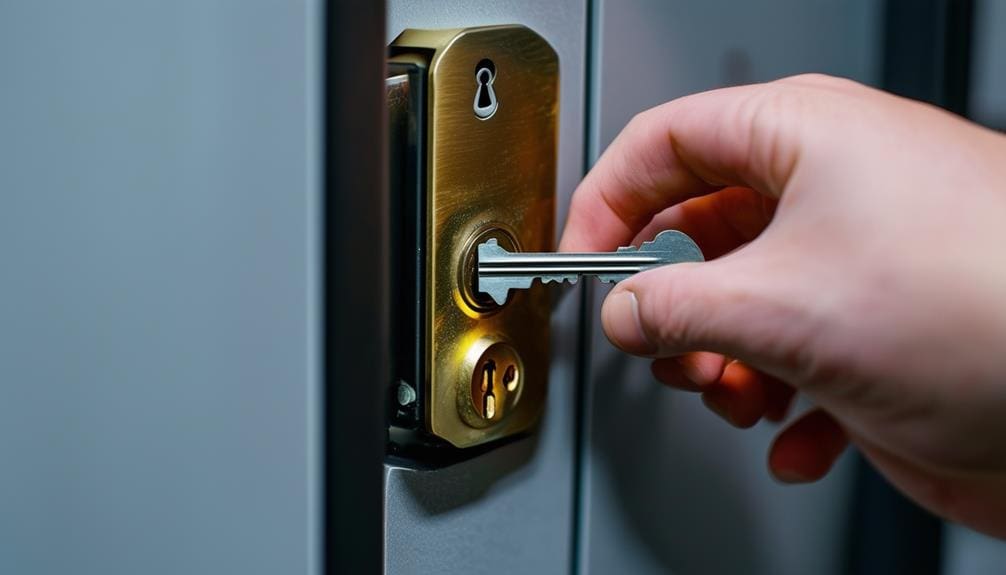
Override keys are essential for guaranteeing you can access your safe during electronic failures or emergencies. They provide a reliable backup method, enabling you to retrieve important items without delay. Understanding how and when to use these keys guarantees you won’t be locked out in critical situations.
Emergency Access Methods
In emergency situations, having a backup method to access your safe is essential, and that’s why override keys are indispensable. Override keys provide a reliable emergency access method when electronic system failures occur. If your safe’s electronic lock malfunctions or the batteries die, you can immediately use the override key to gain access. This backup method ensures you can retrieve important documents or valuables without delay.
When you face crucial situations, like needing to access a will, passport, or emergency cash, having an override key is essential. Forgetting your password or experiencing a lockout shouldn’t prevent you from reaching these vital items. Locksmiths can also use override keys to bypass electronic locks swiftly, offering immediate access if you’re unable to open the safe yourself.
To effectively use the override key, locate the keyhole typically hidden behind a removable panel on the safe. Insert the key and turn it to open the safe manually. It’s important to store the override key in a secure but accessible place, separate from the safe, to ensure it’s available when needed. By integrating an override key, you maintain continuous access to your safe, regardless of electronic complications.
Security and Accessibility
You need to understand that having an override key not only provides an emergency access method but also greatly enhances the security and accessibility of your safe. When electronic locks fail or you forget the combination, override keys serve as a critical backup method. This guarantees you can always access important documents or valuables during emergencies.
Consider the following table to highlight the key benefits of override keys:
| Aspect | Benefit | Explanation |
|---|---|---|
| Security | Enhanced Security | Prevents lockouts due to technical failures |
| Accessibility | Improved Accessibility | Ensures access to safe contents during emergencies |
| Peace of Mind | Maintained Preparedness | Provides reassurance in unforeseen circumstances |
| Reliability | Backup Method | Offers a reliable alternative to electronic locks |
Types of Override Keys
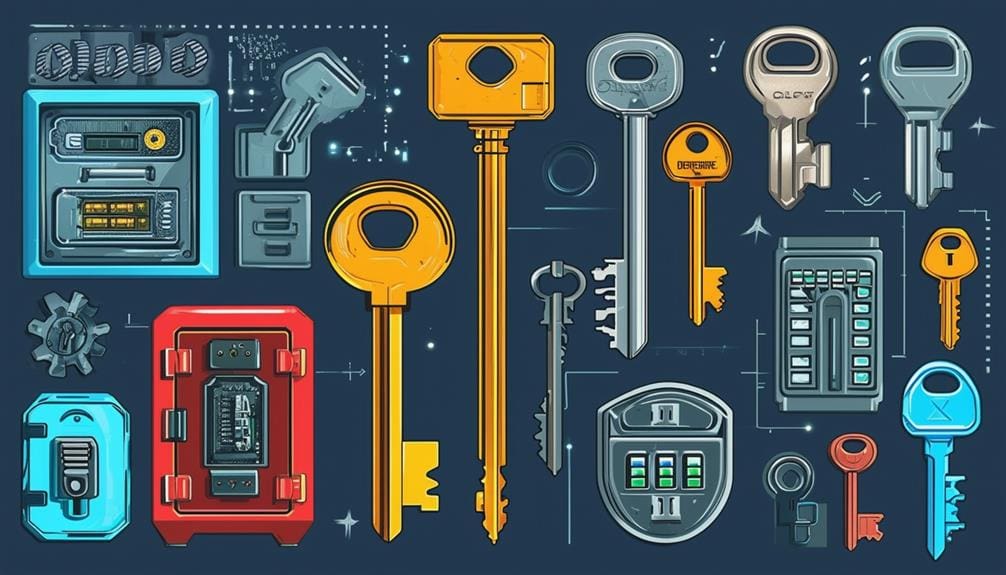
Understanding the various types of override keys is indispensable to ensuring you can access your safe when electronic or mechanical failures occur. Override keys come in different shapes and sizes, tailored to the safe manufacturer and specific safe model. There are two main types of override keys: mechanical override keys and electronic override keys. Mechanical override keys typically feature a traditional key design, requiring manual insertion and turning. They provide a straightforward, reliable backup when electronic systems fail.
On the other hand, electronic override keys often consist of digital components that interact with the safe’s electronic locking mechanism. These might need specialized tools or knowledge to operate effectively, depending on the safe’s design and complexity. Understanding the type of override key your specific safe requires is vital for successful access. Some override keys are unique to particular safe brands, while others might have universal applications. However, always consult your safe manufacturer’s guidelines to determine the correct key type and usage procedures.
How Override Keys Work
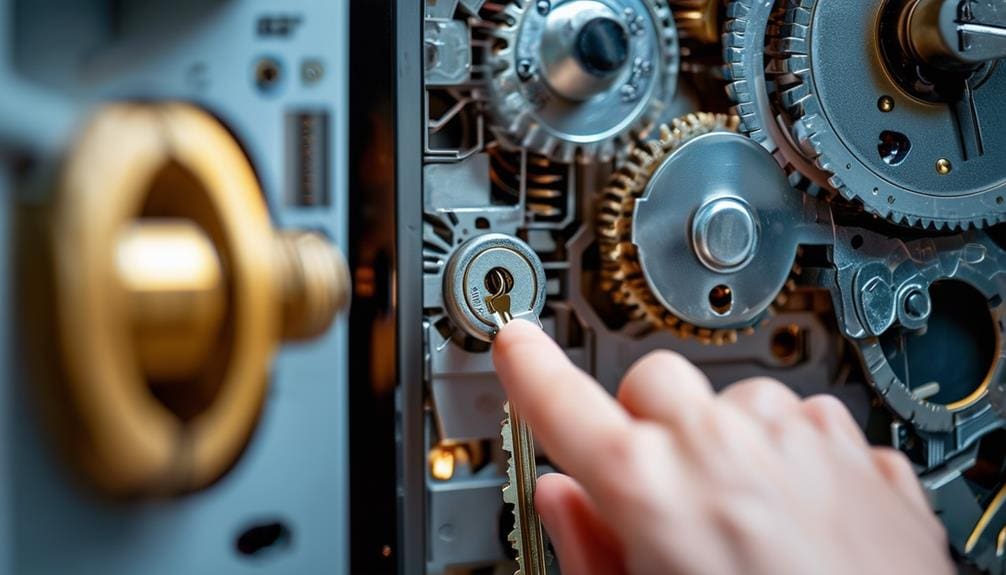
When you insert an override key into the keyhole, it bypasses the electronic system by engaging the manual mechanism. This action directly activates the deadbolt, allowing you to open the safe without needing a password or combination. As a result, you can access the safe even if the electronic components fail or the batteries are depleted.
Bypassing Electronic Systems
Override keys enable you to manually access safes by directly engaging the locking mechanism, bypassing the electronic system entirely. These keys are crucial when the electronic locking mechanism fails, such as due to battery depletion or system malfunction. To utilize an override key, locate the keyhole, which is often hidden behind a panel or keypad on the safe.
Insert the override key into the keyhole. As you turn the key, it manually manipulates the internal locking mechanism, effectively bypassing the electronic lock. This action physically moves the locking bolts into the open position, granting you access to the safe’s contents.
Using override keys is straightforward but requires careful handling. Make sure the key is inserted fully before turning to avoid damaging the internal components. Override keys serve as a critical backup for electronic locks, ensuring you can access your valuables in an emergency.
Understanding how these keys work means you’re prepared for situations where the electronic system might fail. By mastering the use of override keys, you maintain uninterrupted access to your essential items, reinforcing the security and reliability of your safe.
Manual Deadbolt Activation
To manually activate the deadbolt on a safe with an electronic lock, insert the override key into the designated keyhole and turn it to engage the mechanical locking mechanism directly. This process bypasses the electronic system entirely, allowing you direct access to the safe’s interior.
Override keys are vital in emergencies when the electronic lock fails or the battery is dead. By turning the key, you’re engaging the mechanical lock, which functions independently of the electronic components. This backup method guarantees that you can always access your valuables, even if the electronic system is compromised.
For safe maintenance and security, it’s crucial to comprehend how override keys work. Start by locating the keyhole, often concealed for added security. Insert the key fully into the keyhole. Turn the key clockwise or counterclockwise as specified by your safe’s manufacturer. This action manually moves the deadbolt, opening the safe without needing the electronic code.
Regularly check the condition of your override keys and make sure they’re stored in a secure, accessible location. This practice enhances your overall security and ensures you’re prepared for any scenario where the electronic lock might fail, maintaining reliable access to your safe.
Using an Override Key
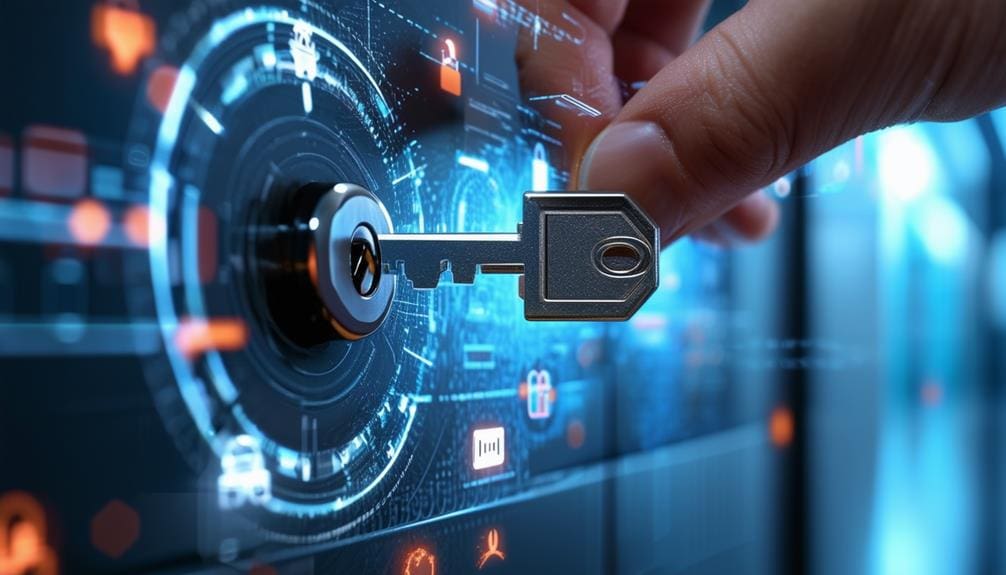
Inserting the override key into the safe’s designated slot immediately bypasses the electronic locking mechanism, granting you direct access. This key serves as an essential backup for electronic locks, ensuring you can still access your safe during emergencies or if the electronic system fails.
To use the override key, first locate the key slot, typically hidden behind a removable panel on the safe’s front. Insert the key fully into the slot. Rotate the key in the direction indicated, usually counterclockwise or clockwise, until you hear a click. This action disengages the electronic lock, enabling the manual opening of the safe door.
Override keys are designed for situations where you can’t rely on electronic access, such as battery depletion or malfunction. Locksmiths also use these keys to quickly and efficiently open safes without causing damage. Remember, the override key is your immediate solution for emergencies, offering a straightforward path to your valuables without needing the correct password or combination.
Using the override key effectively requires understanding its role and precise operation. Keep the key in a secure, easy-to-remember location, ensuring you’re always prepared for unexpected lockouts. This knowledge guarantees that your valuables remain accessible, no matter the circumstance.
Risks of Override Keys
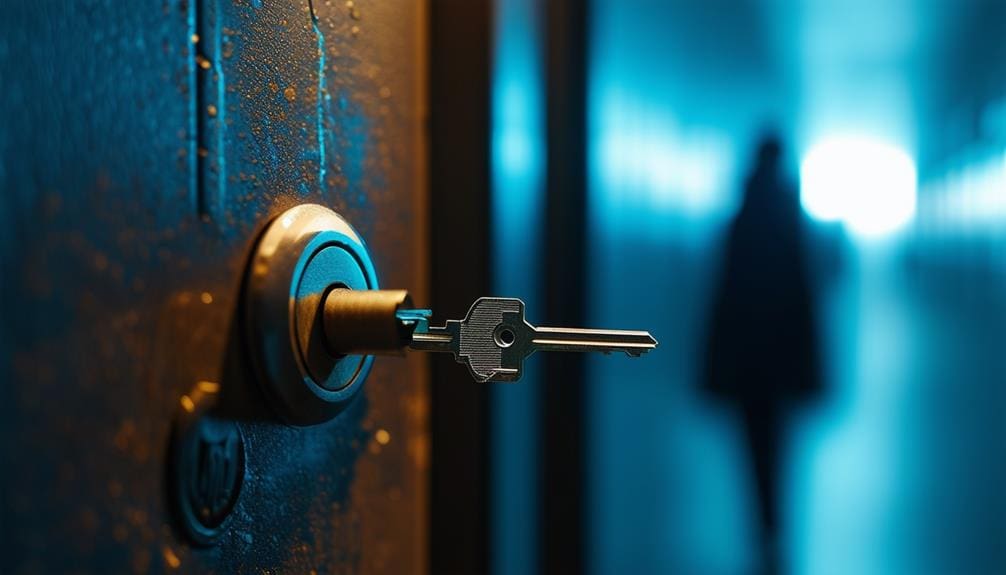
Given their importance, override keys can pose significant security risks if not properly safeguarded. If an override key falls into the wrong hands, it can lead to unauthorized access, compromising the security of your safe. To prevent security breaches, you must make sure that the location of the override key remains confidential. Never disclose its whereabouts to anyone who doesn’t absolutely need to know.
Here’s a quick look at the risks associated with override keys:
| Risk | Description |
|---|---|
| Unauthorized Access | Anyone with the key can bypass electronic locks. |
| Compromised Security | Knowledge of an override key’s existence can weaken overall security. |
| Security Breach | Misplaced keys can lead to potential theft or data exposure. |
| Confidentiality Concerns | Sharing key location can expose safes to unauthorized individuals. |
Override keys need to be securely stored to mitigate these risks. Avoid common hiding spots, and consider using a secondary lockbox or a different secure location. Remember, the fewer people who know about the override key, the lower the risk of unauthorized access. By understanding and addressing these risks, you can preserve the integrity of your security systems effectively.
Security Measures
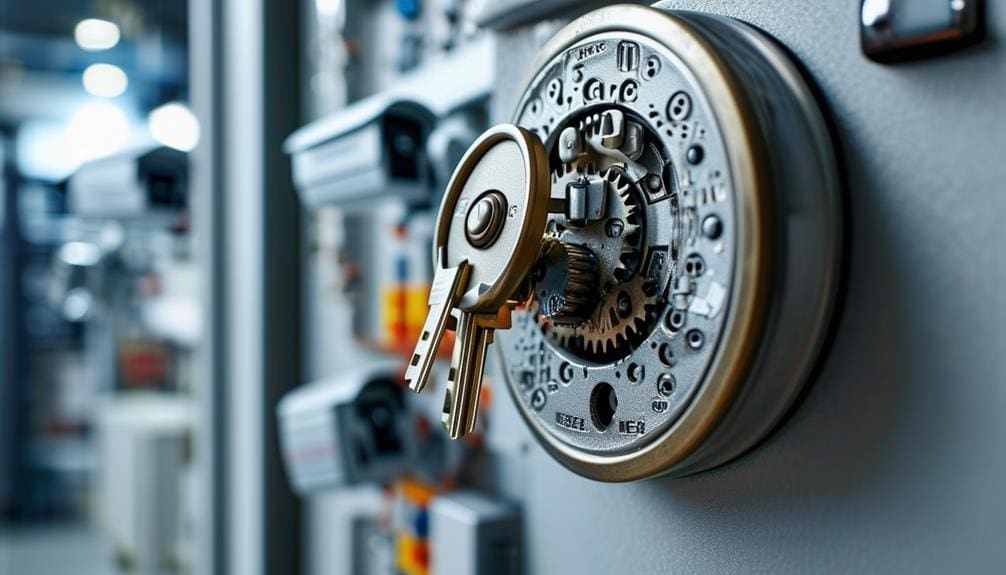
Implementing strong security measures for your override key is vital to guarantee the safe remains secure from unauthorized access. First, make sure you store the override key in a secure, undisclosed location. Avoid discussing its existence or location openly. This reduces the risk of potential breaches.
Next, consider integrating your override key into your overall security system. Safe security isn’t just about the safe itself but also about how you manage access to your override key. Use lockboxes or safes designed specifically for key storage to add another layer of protection.
It’s also important to consistently monitor and update your security measures. Keep in mind that override keys make it easier for authorized access during emergencies, but they can be a vulnerability if not properly secured. Regularly check that the key’s hiding spot remains undisclosed and secure.
Furthermore, if you must use an override key, make sure it’s done discreetly and promptly returned to its secure location. By following these steps, you can effectively prevent unauthorized access and maintain the integrity of your safe security. Remember, the goal is to balance accessibility with security, making sure that your valuables remain protected at all times.
Maintenance Tips
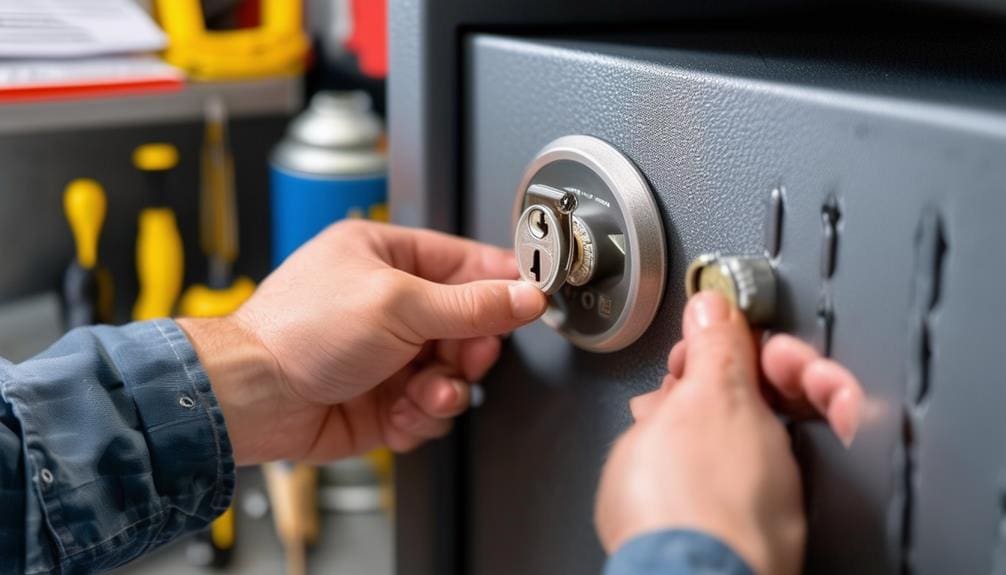
Regularly inspecting your safe for wear or damage is important to prevent lock malfunctions and guarantee smooth operation. Start by visually examining the exterior and interior for any signs of wear or damage. This can help you detect issues early before they escalate.
Next, focus on the locking mechanism. Clean it gently using a soft cloth to remove dust and debris, then apply a suitable lubricant. This simple step ensures that the locking mechanism operates smoothly and reduces the risk of lock malfunctions.
Override keys are essential for safes with advanced security features. Test these keys periodically to make sure they still function correctly. Insert the override key and test the locking and opening processes. If you notice any resistance or irregularities, address them immediately.
Additionally, regularly testing the safe’s locking functions can anticipate potential problems. Ensure that both the primary and override mechanisms work without any interruptions.
Always follow the manufacturer’s guidelines for safe maintenance. These instructions are tailored to your specific model and can greatly extend the lifespan of your safe. Proper maintenance is essential for the best performance of modern safes with advanced security features.
Dealing With Failures

When your safe fails, first identify the common issues such as dead batteries or jammed mechanisms. If these simple fixes don’t work, consider resetting the combination or contacting a professional locksmith. Avoid DIY attempts as they can damage the safe and compromise its security.
Identifying Common Issues
To effectively deal with safe lock failures, identify whether the issue stems from dead batteries, jammed components, or worn parts. Begin by evaluating the battery status, as many electronic systems inside safes rely on power to function. If the batteries are depleted, replacing them might resolve the issue without needing to bypass the electronic mechanism.
If the problem persists, consider whether mechanical parts are stuck. In such cases, override keys come in handy. These keys allow you to access the safe without the electronic lock knowing, providing a manual solution to the problem. However, if the safe doesn’t have an override, you may need professional locksmiths to get inside and address more complex issues.
Worn parts can also lead to failures. Over time, components such as keypads or internal locking mechanisms may degrade. Understanding safe operation and maintenance can prevent such issues. If you suspect worn parts, a locksmith can replace them to restore functionality.
In rare cases, the entire electronic lock may fail. While this is uncommon, it’s essential to understand the security vulnerabilities and measures of individual electronic locks to guarantee safe operation and address any potential weaknesses effectively.
Safe Reset Procedures
Safeguarding your valuables often involves knowing how to reset your safe’s combination or access code when failures occur. Safe reset procedures can vary depending on the type of lock, but here’s a general guide to help you navigate this process efficiently.
First, avoid DIY fixes unless you’re absolutely sure of your method. Incorrect attempts can cause more damage. If your safe uses an electronic lock, you might encounter electronic lock failures. These often require professional safe locksmith services to reset codes or replace faulty components.
Here’s a step-by-step guide to access the safe and reset it:
| Step | Action | Description |
|---|---|---|
| 1 | Identify the Issue | Determine if it’s a forgotten code or electronic failure. |
| 2 | Consult the Manual | Follow the manufacturer’s reset procedures. |
| 3 | Contact a Locksmith | If unresolved, hire professional safe locksmith services for safe opening. |
Technicians have the expertise to diagnose and fix issues, ensuring your safe remains secure. They can easily reset codes for forgotten combinations and address any electronic lock failures effectively. Always prioritize professional help over DIY fixes to maintain the integrity and security of your safe.
Professional Help Options
If reset procedures don’t resolve the issue, it’s time to explore professional help options for dealing with safe failures. When you encounter persistent problems with your safe locks, especially electronic lock failures, seeking professional assistance is often the best course of action. Here’s why and how you should proceed:
- Contact a Professional Locksmith:
Locksmith services are your go-to for safe opening when override keys and DIY fixes fail. These experts can handle a variety of lock types and have specialized tools to open safes without causing damage.
- Avoid DIY Fixes:
Attempting to address electronic lock failures on your own can worsen the problem. Without proper knowledge, DIY fixes might escalate the situation, making it even more challenging for a locksmith to resolve later.
- Rely on Expertise:
Professional locksmiths have the skills to handle electronic lock failures and mechanical issues. They can easily open any existing safe lock and address underlying problems without guessing combinations or attempting impractical resets.
Always remember, professional assistance guarantees your safe is opened efficiently and securely. Don’t hesitate to reach out to a locksmith when facing serious lock issues.
Choosing Locksmith Services

When selecting locksmith services, it’s essential to prioritize a reputable provider who can expertly handle safe override keys. First, research locksmith services that specialize in safes and vaults. This guarantees they have the proper expertise to assist with your specific requirements.
Next, verify their credentials. A reputable locksmith should be licensed, insured, and bonded. This not only confirms their legitimacy but also safeguards you in case of any mishaps during the process. Ask for references or read reviews from previous clients to assess their reliability and professionalism.
Once you’ve identified a potential locksmith, inquire about their experience with safe override keys. They should be skilled at locating and accessing the override key without causing damage to your safe. Their expertise ensures safe and secure access to your valuables.
It’s also important to discuss the tools and techniques they use. A skilled locksmith will have specialized equipment and knowledge for the proper handling of override keys. This reduces risks and guarantees the job is done efficiently.
Frequently Asked Questions
How to Use Override Key on Safe?
To use an override key, locate the keyhole on the safe, insert the key, and turn it. Override key benefits include bypassing lockout scenarios. Guarantee secure key storage, follow safe security measures, and control key access.
How to Use Override Key?
Using an override key involves understanding its benefits and limitations. Guarantee proper setup, follow security best practices, and troubleshoot if necessary. Consider alternatives to enhance security. Prioritize a thorough, step-by-step approach for safe access.
What Does an Override Key Do?
An override key provides secure access when electronic systems fail. Its function includes bypassing locks, ensuring you can retrieve valuables. Benefits include emergency access, but limitations like potential misuse exist. Best practices involve careful implementation.
How Do Safe Keys Work?
Safe keys work by physically bypassing electronic locks. Override key benefits include emergency access and reliability. Override key process involves inserting and turning. Override key security is high, but limitations exist. Override key importance can’t be overstated.
Conclusion
So, you’ve now got the ultimate key to understanding safe override keys. They’re not just a convenience; they’re a lifeline in emergencies. By knowing the types, how they work, and when to use them, you’re prepared for anything—like a superhero with a keyring! Remember to maintain your keys and consult professional locksmith services when needed. With this knowledge, you’re not just opening safes; you’re opening peace of mind.

